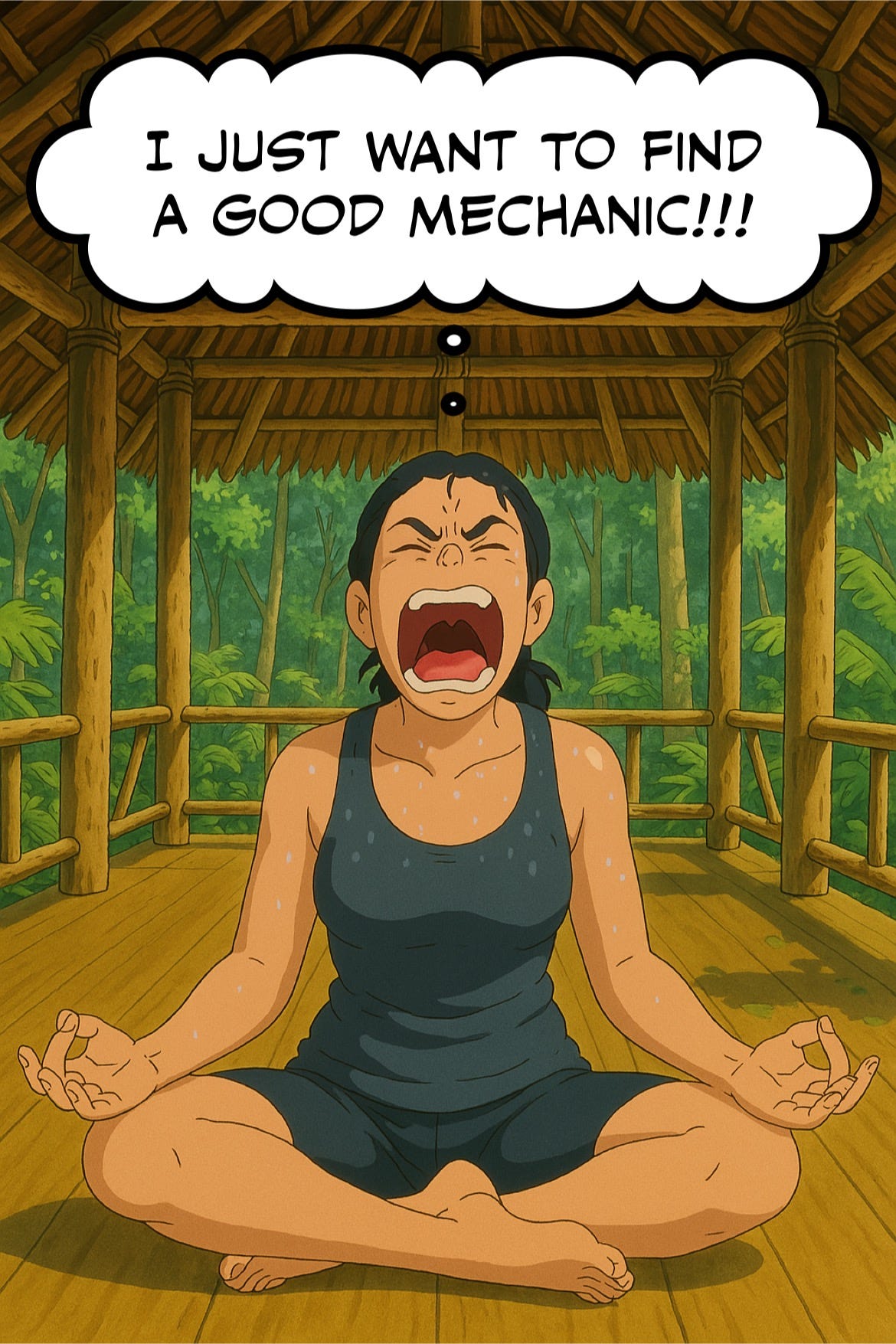One thing many visitors notice when they come to the area is how fit everyone is. Most people that live here seem to be in a good physical shape. Is it the “healthy lifestyle” that we got going here? May be it’s lack of fast food or really much restaurants in the area, forcing most of us to cook at home using whole foods ingredients(or at least the ones we can find)? Perhaps its just the heat—you sweat so much just by taking a stroll during the day, the weight seems to just evaporate off your skin. Or it’s all the exercises and sports that we love to do!
And before I go on a communal ego-trip of “look at us, we’re so healthy, we run!”, let me just state upfront that I believe the main reason for this is there isn’t much else to do around here. It’s not like you can go to the movies - you’d be driving for an hour, or eat out - we have limited options, or visit one of those hipster coffee shops - we don’t have one, or browse the latest books at the local bookstore - sorry, not here. So one is left with few basic choices of either going on a stroll or screaming at the top of their lungs at 6:30 in the morning at the Yoga Shala.
But back to Sports. We love sports! There is a soccer game, twice a week, a basketball game once a week, a volleyball game every Sunday, a surfers group that goes out regularly, weekly river hikers, pool swimmers, power yoga, private tennis and pickle ball court that you can join if you know the right people and of course the daily morning workout groups in both La Ecovilla and Alegria with weights, rubber bands, high-energy music and a rotation of trainers that can give any Colorado gym trainer a run for their money.
The one “sports” activity that I want to go deeper into today and one I personally enjoyed in the last 2+ years is “Boxing”. The reason I put both sports and boxing in quotes is because while we do box and it is certainly a sport, the way we approach it and the benefits we get from the practice go far beyond what you’d consider in any sport.
Background
About 3 or so years ago a family moved into the area (they have since moved back to US), and the husband, James, was a strange looking fellow, with long hair, a particular jungle-hipster dress code, always carrying a stick or two in his hands, ready to strike and a big knife on the belt, just in case. The most distinctive feature is of course the intense stare with which he’d pierce anyone that came into his field of view. If you’ve never spent much time with James, the initial reaction might be “What’s the deal with that guy?”, but if you spent only a few hours talking to him, you’ll quickly recognize the deep wisdom of not judging the book by it’s cover.
James spent a good part of his life learning, practicing and teaching various martial art techniques and few years back he started teaching them here. Sometimes stick fighting with kids, other times teaching adults Filipino Kali Boxing, a particular style of boxing that he enjoys. I started learning 1-on-1 with James 2.5 years ago and we eventually expanded the class to a small group which continues to practice twice a week. Even though James is no longer here, he continues to provide his guidance remotely, reviewing our video fights, giving feedback and general direction.
If you were to observe one of our practice sessions, it would resemble some sort of Fight Club inspired gathering where a bunch of guys, get together and try to punch each other in the face. Though unlike Fight Club, the punching is pretty light and the gloves are pretty big so nobody gets hurt. The intent behind the practice and the container created are quite different. Yes, we mostly spar with each other and Yes, we mostly try to actually hit each other in the head using 50% or less of our strength, but the reason we do it is because we are actually practicing nervous system regulation and developing skills to heighten our awareness of senses in a stressful scenario.
Fight-or-Flight
The fight-or-flight response is your body's automatic, built-in system designed to protect you from perceived danger. It’s part of the sympathetic nervous system that kicks in during stressful or threatening situations. Say you perceive a threat(real or otherwise), your brain (specifically the amygdala) interprets the threat and signals the hypothalamus, which then activates the sympathetic nervous system. Once activated, the body releases a surge of stress hormones, like adrenaline and cortisol, leading to a bunch of physical changes. The heart beats faster, the breathing speeds up to take in more oxygen, pupils dilate to improve vision, muscles tense, sweating increases to cool the body down, etc.
While this response is super helpful in life-threatening situations, the fight-or-flight response can be over-activated by modern stressors like work pressure or social anxiety. That’s why practices like yoga, mindfulness, breathwork, and somatic release are helpful—they activate the parasympathetic nervous system (rest and digest), helping your body downshift from the stress state.
Fight-or-Flight & Emotions
The fight-or-flight response isn’t just physical. It’s deeply tied to your emotional system, especially fear, anger, and overwhelm. When you’re triggered, your brain’s alarm system hijacks the more rational parts of your brain, so you feel first and think later. In a healthy system, once the threat is gone, your body comes back to baseline. But sometimes—especially with trauma or chronic stress—the nervous system gets stuck in a state of activation. That means your body still thinks the threat is there, even when it's not. This can show up as anxiety or hyper-vigilance, outbursts of anger or irritation, numbness, shutdown, or dissociation, trouble sleeping, digesting, or focusing, feeling “on edge” or “off” for no clear reason.
When someone goes through trauma (especially if they couldn’t fight or flee), the survival energy doesn’t get discharged. It gets stored in the body—and that’s where somatic (body-based) work comes in. Your body remembers what your mind might not. This is where things like screaming in a yoga pose, shaking, trembling, or crying during breathwork come in. They’re not weird—they’re signs your body is releasing pent-up survival responses. They’re literally completing the loop your nervous system never got to finish in the moment of the original stress.
Alright Dr. ChatGPT, but what does this have to do with Boxing?
When we box and the reason we focus a lot on sparring is that unlike other sport activities, we are intentionally trying to put the body in a fight mode. When you intentionally activate a stress response in a safe, controlled environment, and then successfully return to baseline, you're training your nervous system to do the same in real life. This is a principle called Stress Inoculation (a term from psychology and military training). You expose yourself to small, manageable doses and learn to handle it.
Boxing turns up your interoception—your ability to feel and interpret internal signals (like heart rate, muscle tension, breath patterns). According to trauma researcher Bessel van der Kolk and somatic experts like Peter Levine, increasing interoceptive awareness is critical for nervous system regulation and trauma healing. You’re not just fighting—you’re learning to read the body’s signals under pressure.
When boxing is practiced with presence, trust, and awareness, it also builds co-regulation—the ability to stay connected and attuned with others while in stress. You're not just fighting an opponent; you're dancing with another nervous system.
We joke sometimes that our sessions resemble dancing more than fighting and there is some deep truth in that, over time we develop a stronger connection to each other through the act of combat learn things about ourselves and each other that would otherwise not surface. I’ve known Zach, JP and Bjoern for sometime, but its only through our common fighting practice that we’ve deepened our relationships and also learned, sometimes surprising things about each other.
The bottom line is what we’re actually doing is activating our sympathetic system and then downshifting into parasympathetic state, gradually increases the levels according where each person is at. This builds flexibility in in our nervous system or what the scientists would call Autonomic Flexibility. This is associated with higher heart rate variability (HRV), better emotional regulation, and even improved immune function.
So do you learn to fight too?
Yes. Even though oddly enough thats not always our main objective, inevitably through practice we do learn to fight, including basic fighting and defending techniques, body positioning, footwork, engagement tactics and strategy. Just as importantly we learn to be comfortable in a fight, including overcoming psychological barriers of hitting another human being as well as receiving a hit.
This all sounds very violent, I smell toxic masculinity…
You meant Divine Masculinity, surely. The whole “toxic masculinity” conversation gets thrown around a lot, but at the core of it, what we’re really talking about is disconnection—disconnection from the body, from emotion, from vulnerability. Real masculinity, the kind I want to embody, is about presence. It’s about knowing what you’re feeling and being able to hold that without blowing it out sideways. Strength that doesn’t need to dominate. Power that doesn’t need to posture. Boxing, when done right, taps into that. It’s not about suppressing the fighter—it’s about integrating him. Learning how to feel anger without becoming it. Learning how to move energy through the body without hurting yourself or someone else in the process.
Yes, it’s a bit Jungian—shadow work with gloves on. It’s about taking that raw, unprocessed charge and channeling it into something solid and steady. And yeah, I know we’re walking a fine line between “boxing as a sport” and “woo-woo warrior retreat,” but the experience is real.
We often mistake masculinity for control—don’t cry, don’t feel too much, don’t look weak. But what we’re discovering through this practice is that true masculinity is about containment. Can I hold this intensity? Can I feel this surge of energy and not collapse, not lash out, not shut down? Can I stay open even in the discomfort?
This practice—this weird, beautiful ritual of putting on gloves and gently trying to knock each other around—isn’t about proving who’s stronger. It’s about showing up fully. It’s about growing together, being real with each other, challenging each other, supporting each other. And in that process, we learn how to feel safe with each other. How to trust. How to show up as people who are fully alive.
And just to be clear, while I used the word “masculinity” a lot above, this is not in any way gender-specific, everything applies to both men and women as we all carry masculine and feminine energies within us.
So can I join?
Glad you asked. Absolutely. Currently we train Fridays at 11am and Sundays at 9am at the LEV Yoga Shala, though we’re open to vary the location if there is interest to do it elsewhere. We also discussed an evening practice which we might introduce, depending on interest. All levels are welcome and no prior experience is needed, we even have extra gloves. There is also no charge and no “master”. While I tend to do a bit of coaching, especially if you’re just starting out, the focus is on co-practice and co-coaching through reflection. Both Men and Women are welcome, if a there is interest in a women-only group, I’m happy to support it. Reach out - or just come and try one day. Should a group of beginners materialize, I’m happy to run an intro series.
If you want to see what this looks like in practice and “meet” James, check out our mini 8-minute documentary:





